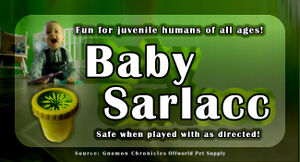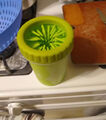Baby Sarlacc: Difference between revisions
No edit summary |
No edit summary |
||
| Line 24: | Line 24: | ||
== External links == | == External links == | ||
* [https:// | * [https://twitter.com/GnomonChronicl1/status/1384527564597825536 Post] @ Twitter (20 April 2021) | ||
* [https://twitter.com/GnomonChronicl1/status/1332884382118457345 Post] @ Twitter | * [https://twitter.com/GnomonChronicl1/status/1332884382118457345 Post] @ Twitter | ||
* [https://www.facebook.com/karl.gregory.jones/posts/10224700350834753 Post] @ Facebook | * [https://www.facebook.com/karl.gregory.jones/posts/10224700350834753 Post] @ Facebook | ||
* [https://en.wikipedia.org/wiki/Sarlacc Sarlacc] @ Wikipedia | |||
[[Category:Fiction (nonfiction)]] | [[Category:Fiction (nonfiction)]] | ||
Revision as of 08:21, 20 April 2021
Baby Sarlacc is a trade name for a juvenile sarlacc, popular as a novelty pet.
While the adult sarlacc, a multi-tentacled alien beast whose immense, gaping maw is lined with several rows of sharp teeth, is deadly dangerous and widely feared, the juvenile sarlacc is relatively harmless.
The sarlacc catches its prey with a trapping structure formed by the terminal portion of each of the sarlacc's tentacles, which is triggered by tiny hairs (called "trigger hairs" or "sensitive hairs") on their inner surfaces.
Adult sarlaccs feed mainly upon condemned criminals and unlucky bounty hunters, while juvenile sarlaccs feed upon insects, rodents, and small hominids such as immature ewoks.
Although widely harvested for sale, the population of the baby sarlacc has been rapidly declining in its native range. The species is currently under Extraterrestrial Species Act review by the U.S. Space & Alien Life Service.

